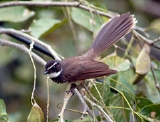
White-throated Fantail
Encyclopedia
-_albogularis_race-_chicks_in_nest_in_anantgiri,_ap_w_img_8921.jpg)
Passerine
A passerine is a bird of the order Passeriformes, which includes more than half of all bird species. Sometimes known as perching birds or, less accurately, as songbirds, the passerines form one of the most diverse terrestrial vertebrate orders: with over 5,000 identified species, it has roughly...
bird
Bird
Birds are feathered, winged, bipedal, endothermic , egg-laying, vertebrate animals. Around 10,000 living species and 188 families makes them the most speciose class of tetrapod vertebrates. They inhabit ecosystems across the globe, from the Arctic to the Antarctic. Extant birds range in size from...
. It is found in forest, scrub and cultivation across tropical southern Asia from the Himalayas
Himalayas
The Himalaya Range or Himalaya Mountains Sanskrit: Devanagari: हिमालय, literally "abode of snow"), usually called the Himalayas or Himalaya for short, is a mountain range in Asia, separating the Indian subcontinent from the Tibetan Plateau...
, India
India
India , officially the Republic of India , is a country in South Asia. It is the seventh-largest country by geographical area, the second-most populous country with over 1.2 billion people, and the most populous democracy in the world...
and Bangladesh
Bangladesh
Bangladesh , officially the People's Republic of Bangladesh is a sovereign state located in South Asia. It is bordered by India on all sides except for a small border with Burma to the far southeast and by the Bay of Bengal to the south...
east to Indonesia
Indonesia
Indonesia , officially the Republic of Indonesia , is a country in Southeast Asia and Oceania. Indonesia is an archipelago comprising approximately 13,000 islands. It has 33 provinces with over 238 million people, and is the world's fourth most populous country. Indonesia is a republic, with an...
. It has numerous subspecies
Subspecies
Subspecies in biological classification, is either a taxonomic rank subordinate to species, ora taxonomic unit in that rank . A subspecies cannot be recognized in isolation: a species will either be recognized as having no subspecies at all or two or more, never just one...
, including R. a. albogularis of Peninsular India, which is often treated as a separate species, the White-spotted Fantail or Spot-breasted Fantail (R. albogularis).
Description
_at_narendrapur_i_img_7624.jpg)
Local names for the bird in India
India
India , officially the Republic of India , is a country in South Asia. It is the seventh-largest country by geographical area, the second-most populous country with over 1.2 billion people, and the most populous democracy in the world...
include – Nasoni sorai in Assamese
Assamese language
Assamese is the easternmost Indo-Aryan language. It is used mainly in the state of Assam in North-East India. It is also the official language of Assam. It is also spoken in parts of Arunachal Pradesh and other northeast Indian states. Nagamese, an Assamese-based Creole language is widely used in...
.
Behaviour
-_albogularis_race_in_anantgiri,_ap_i_img_8753.jpg)
Egg (biology)
An egg is an organic vessel in which an embryo first begins to develop. In most birds, reptiles, insects, molluscs, fish, and monotremes, an egg is the zygote, resulting from fertilization of the ovum, which is expelled from the body and permitted to develop outside the body until the developing...
s in a small cup nest in a tree.
The White-throated Fantail is insectivorous, and often fans its tail as it moves through the undergrowth.
Not normally renowned as a songster, the male of R. a. albogularis, the peninsular race, uses a fixed and unmistakable pattern of musical notes in its call. The notes are loud and normally divided into two stanzas – the first with 5–6 trilling notes rising and falling, followed by 4–5 notes rising up the scale and ending in the highest note.
Birds use the same song year after year, with progressively small changes, with the result that the song sounds very different after 4–5 years. The male's call is a valuable tool in detection and identification of the bird, which can often be confused with the White-browed Fantail
White-browed Fantail
The White-browed Fantail, Rhipidura aureola, is a small passerine bird.The White-browed Fantail breeds across tropical southern Asia from India and Sri Lanka east to Vietnam. This species is found in forest and other woodland. Three eggs are laid in a small cup nest in a tree.- Description :The...
, R. aureola, where their ranges overlap. R. aureola has light underparts and prominent spots in two rows on the wings. Its call is rather functional, and not as pleasant and aesthetic as that of R. albicollis.

